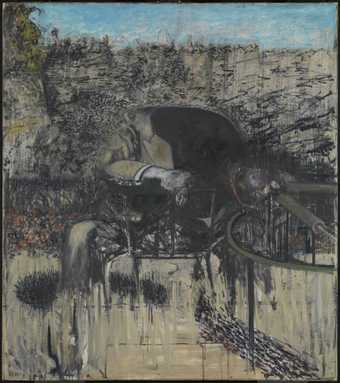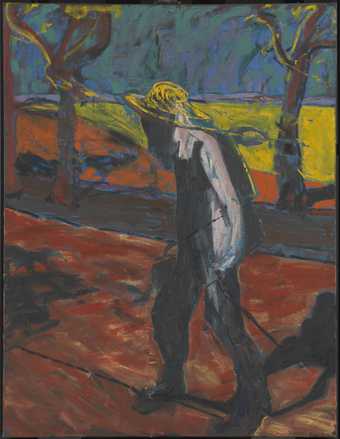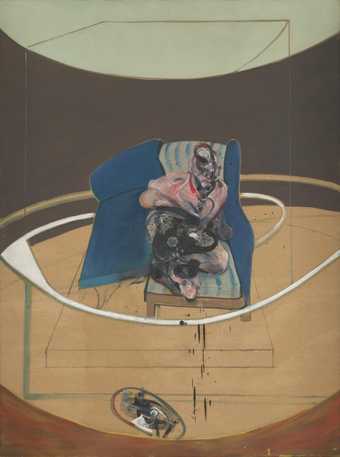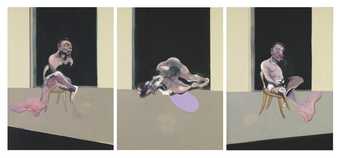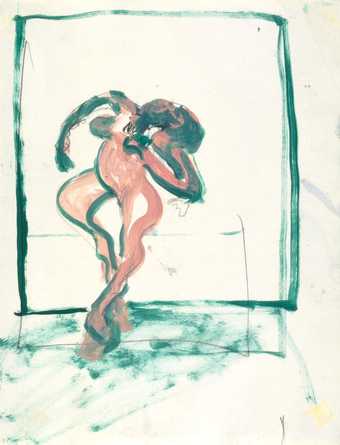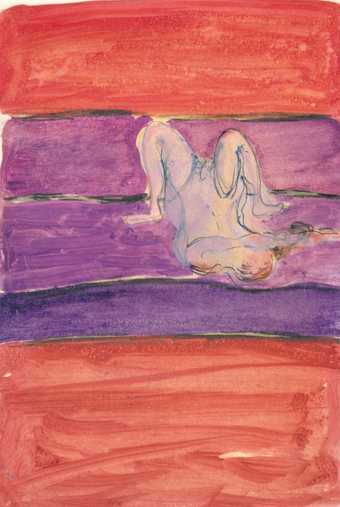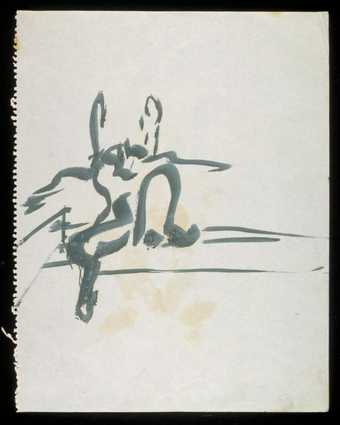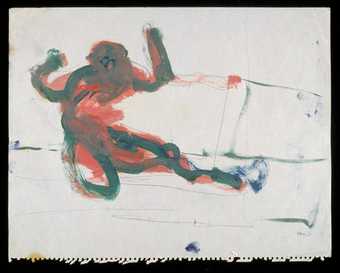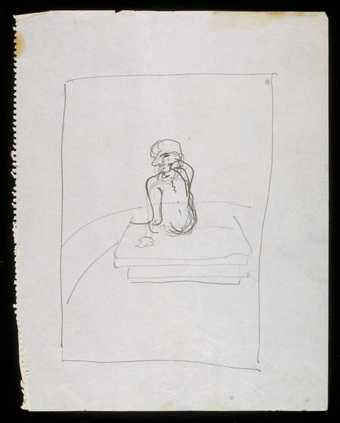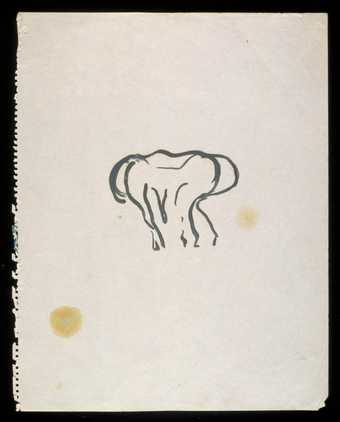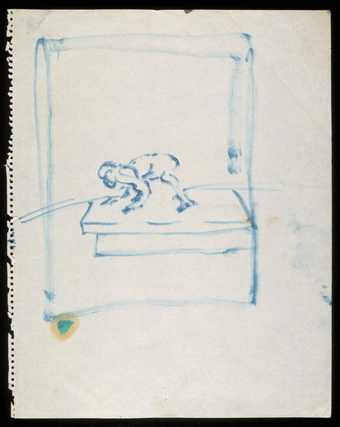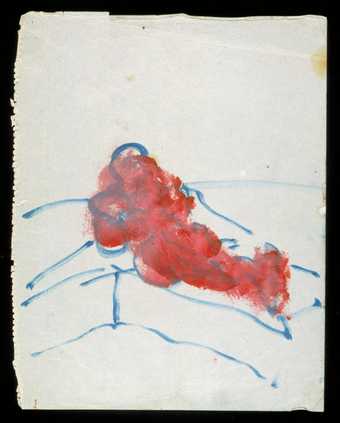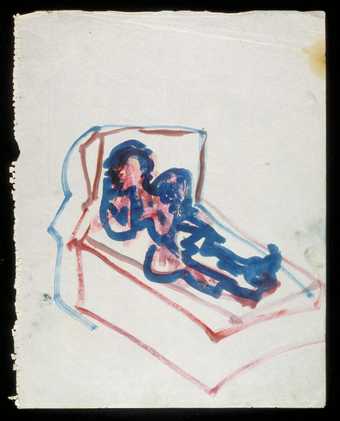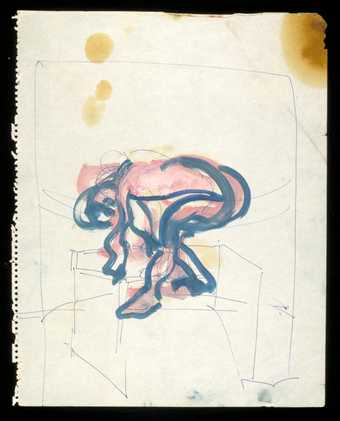
In Tate St Ives
- Artist
- Francis Bacon 1909–1992
- Medium
- Oil paint on canvas
- Dimensions
- Support: 1651 × 1422 mm
frame: 1853 × 1627 × 90 mm - Collection
- Tate
- Acquisition
- Presented by J. Sainsbury Ltd 1961
- Reference
- T00459
Display caption
Bacon’s portraits are explorations of the human condition as much as they are character studies, particularly in works such as Seated Figure, in which the identity of the sitter is not disclosed. They also represent a complex exploration of pictorial space: the figure is simultaneously posed among some elegant items of furniture and confined within a box-like frame. This device, which was one of Bacon’s trademarks, underlines the sense of isolation as well as generating a claustrophobic psychological intensity.
Gallery label, July 2012
Does this text contain inaccurate information or language that you feel we should improve or change? We would like to hear from you.
Catalogue entry
Francis Bacon 1909-1992
Seated Figure
1961
T00459
Oil and sand on canvas 1651 x 1422 (65 x 55 13/16)
Presented by J. Sainsbury Ltd., 1961
Provenance:
Purchased from Marlborough Fine Art Ltd., London by J. Sainsbury Ltd. for presentation to the Tate Gallery, 1961
Exhibited:
Francis Bacon, Tate Gallery, London, May-June 1962 (83, repr. in col. as Seated Man with Turkey Rug)
Francis Bacon, Solomon R.Guggenheim Museum, New York, Oct. 1963-Jan. 1964, Art Institute of Chicago, Jan.-Feb. 1964 (52, repr. in col. as Seated Man with Turkey Rug)
Henry Moore to Gilbert and George: Modern British Art from the Tate Gallery, Palais des Beaux Arts, Brussels, Sept.-Nov. 1973, as part of Europalia 73 Great Britain (77, repr. p.91)
Forty Years of Modern Art 1945-1985, Tate Gallery, London, Feb.-April 1986 (no number)
Francis Bacon: Paintings Since 1944, Tate Gallery Liverpool, Feb. 1990-Jan. 1991 (no number, repr. in col. on front cover)
Masterpieces of British Art from the Tate Gallery, Metropolitan Museum, Tokyo, Jan.-March 1998, Hyogo Prefectural Museum of Modern Art, Kobe, April-June 1998 (93, repr. in col. p.153)
Literature:
Tate Gallery Report 1961-2, London 1962, p.17, repr. between pp.26 and 27 (as Seated Man with Turkey Rug)
Ronald Alley, Francis Bacon: Catalogue Raisonné and Documentation, London 1964, p.139, repr. pl.189
Mary Chamot, Dennis Farr and Martin Butlin, Tate Gallery: The Modern British Paintings, Drawings and Sculptures, I, London 1964, p.24
Andrew Forge, ‘Painting of the Month: Seated Figure by Francis Bacon’, Listener, vol.74, no.1915, 9 Dec. 1965, pp.964-5, repr. p.964
John Russell, Francis Bacon, London, Paris and Berlin 1971, 2nd ed. London and New York 1979, 3rd ed. 1993, p.121, repr. p.122, pl.58
John W. Nixon, ‘Francis Bacon: Paintings 1959-1979; Opposites and Structural Rationalism’, unpublished Ph.D thesis, University of Ulster, Belfast 1986, p.585 (no.189)
Ann Stevenson, Poems After Francis Bacon in Pat Adams (ed.), With a Poet’s Eye: A Tate Gallery Anthology, London 1986, pp.124-7, repr. p.127 (col.)
Masterpieces of British Art from the Tate Gallery, exh. cat., Metropolitan Museum, Tokyo 1998, pp.153, 237, repr. p.153 (col.)
Reproduced:
Stephen Spender, ‘Francis Bacon’, Quadrum, no.11, Dec. 1961, p.53
Time and Tide, no.43, 31 May 1962, p.19 (cut at top and bottom)
Edward Lucie-Smith, ‘Images of Our Time’, Listener, vol.67, no.1732, 7 June 1962, p.998 (as Man Seated with a Turkish Rug)
Edwin Mullins, ‘Academy Myths and Private Images’, Apollo, vol.76, no.5, July 1962, p.407, pl.VIII (col.)
John Rothenstein, ‘The Tate Gallery’, Ambassador, No.11, 1962, p.53 (as Seated Man with Turkey Rug)
John Rothenstein, The Tate Gallery, London 1962, p.262 (as Man Seated with a Turkish Rug)
Ronald Alley, ‘Francis Bacon’, Cimaise, vol. 10, no.63, Jan.-Feb. 1963, p.15 (col., as Seated Man with Turquey Rug)
Art in America, vol.51, no.1, Feb. 1963, p.107
John Rothenstein, ‘My Years at the Tate’, Studio, vol.169, no.862, Feb. 1965, p.73, pl.2
Ronald Alley, British Painting Since 1945, London 1966, pl.25
Lorenza Trucchi, Francis Bacon, Milan 1975, trans. John Shepley, London and New York 1976, pl.71
Rory Snookes, ‘Relative Presences: A Roomful of Bacons at the Tate’, Apollo, vol.134, no.357, Nov. 1991, p.350, front cover (detail, col.)
Wieland Schmied, Francis Bacon: Commitment and Conflict, Munich and New York 1996, p.30
Seated Figure is exemplary of Bacon’s favoured techniques as they were consolidated by the beginning of the 1960s. He consistently painted on the reverse side of commercially primed canvas having discovered, in 1947-8, that it provided the right combination of support and ‘tooth’ for his paint.[1]
He often prepared these surfaces with a strong colour; thus, in 1959 a series of works was painted with a vivid green.[2]
The deep red stain on Seated Figure is comparable in effect as it runs across the whole surface and over the top edge, and has been thoroughly absorbed by the canvas.[3]
The figure was then established in black and white, although glimpses of red (such as in the hairline) remain at the junctions to provide a counterpoint. As was Bacon’s practice, the most complex and highly worked areas are in the face. The cheek, neck and forehead are heavily scumbled and sand (or a similar substance) was added to provide bulk to the paint.[4] A hazy layer was then painted across these details.
The result is what John Russell called ‘the multiple image of the head’,[5]
a re-configuration of the features typical of Bacon’s approach. This is usually described in terms which directly identify the realignments with the smearing of the paint. This has been substantiated, to a degree, by the painter’s own account of his method. Describing his resolution of a contemporary portrait, he told Sylvester in 1962: ‘I used a very big brush and a great deal of paint and I put it on very, very freely, and I simply didn’t know in the end what I was doing, and then suddenly this thing clicked, and became exactly like this image I was trying to record.’[6]
This description may be compared with the evidence of Seated Figure, close inspection of which shows bold curves of the brushwork (such as those around the eye-socket). However, the movement of the paint is not directly co-incident with that of the features. It is evident that the face was established from the outset and that the ‘distortions’ of its structure were largely preconceived. An impression of shifted features emerging from the act of painting itself was achieved at the uppermost level of paint and enhanced by the final haze (often retaining the imprint of a cloth) which screens the precision of the original form. In this respect Seated Figure may be exemplary of Bacon’s routine while his comments describe a particular struggle. That this process of modification was bound up with his attitude to portrayal is clear from his explanation of being inhibited by the sitter’s presence because of ‘the injury that I do to them in my work’.[7]
The rest of the body in Seated Figure - especially the sketchy hands - appears to have been painted quickly. The figure is buckled round into one of Bacon’s favourite poses: a tightly cross-legged position with one leg swinging free. It locates the male sitter on the edge of a seat with the concomitant spatial (and perhaps psychological) associations. The remainder of the unusually squareish canvas was completed around the figure: the sofa with some certainty, the chair and precipitous rug less so. Russell has seen a distillation of factual detail in this cursory handling and compared it to Sickert’s practice, stating: ‘We know the man’s taste in shirts and shoes; we could price the Turkey rug; the turned legs on the empty chair can be read quite easily.’[8]
This legibility is achieved with a practised facility most obvious in the heavy working of the rug, where the impasto is up to 1/16 inch (2 mm) deep.[9]
The handling may also betray Bacon’s awareness of the looseness of American abstraction or the concern with matière
amongst French painters in the 1950s. A more extreme instance of such practices is found in the drips and splashes of paint to the right of the figure and below the hands. This exemplifies his professed interest in 1962 in chance effects - ‘in my case all painting ... is accident’ - even as the careful isolation of these effects is indicative of his more qualified explanation of their place in the composition: ‘One is attempting ... to keep the vitality of the accident and yet preserve a continuity.’[10]
The characteristic curtain of vertical strokes in light grey which fills out the background of the painting was applied after the furniture and allowed to penetrate part of the head. As if to acknowledge an awkwardness in this compositional looseness, the white space-frame was superimposed. Carefully ruled - perhaps with the set-square visible in photographs of Bacon’s succesive studios[11]
- the framework runs across the furniture, gathering colour as the line descends. The perspective that it constructs is carefully centred, although the orthogonals of its top converge at a point much lower (to the left of the collar) than those from the base (which converge above the head, within the ‘ceiling’ of the space-frame). Recent analytical research would suggest that such compositional tautness began to be a matter of course for Bacon at around this time.[12]
Certainly, the construction of this space-frame contrasts a disciplined resolution of the composition with the presence of the chance effects.
Although ‘a new largeness of expression’[13]
has been seen to divide Seated Figure from the darker works of the mid 1950s, the painting in many respects serves as a reprise of past elements. The pose closely echoes that used in Portrait of a Man 1953 (private collection)[14]
and achieved with fluency in three works of 1956-7: Study for Figure V (private collection),[15]
Study for Figure VI (Hatton Gallery, Newcastle),[16]
and Study for Portrait IX (private collection).[17]
It was taken up in another canvas, which anticipated by a year the title of the Tate work: Seated Figure 1960 (private collection).[18]
In all of these paintings the subject wears a suit and sits cross-legged; the broad shoulders, carried in a continuous sweep into the unresolved left arm, are contrasted with the pivotal lowered foot. In the Tate’s painting Bacon drew upon but varied these two cardinal aspects of the pose. The shoulders collapse to expose the large protruding head, and allow an echoing of soft forms to the right (collar, shoulder, knee). The figure’s right leg - rather than the left used in the earlier works - provides the support and is drawn improbably towards the lower right corner of the canvas. Within the breadth of the canvas this arrangement may have necessitated the introduction of the visually stabilising chair legs (to the left) and the steeply angled rug.
If the pose in Seated Figure 1961 has echoes of the earlier works, so does the centred linear frame by which the space is determined. The contradiction between this structure and the striated background which slightly overlaps the figure tends to emphasise the flatness of the composition while setting the psychological tone. In an article of 1963 (which carried a colour reproduction of Seated Figure), Ronald Alley noted how the ‘nightmarish incapacity’ of Bacon’s figures ‘to come to terms with the world around them is heightened by his practice of enclosing them in a framework like a glass or of depicting them in a box-like, windowless space - intensely claustrophobic - as if each was confined to his private hell’.[19]
Three years later Sylvester commented upon the ‘claustrophobia and unease’ of the 1956-7 series, and the painter attributed this to qualities in the sitter: ‘this man was very neurotic and almost hysterical [and] this may possibly have come across in the paintings. I’ve always hoped to put over things as directly and rawly as I possibly can, and perhaps, if a thing comes across directly, people feel that that is horrific.’[20]
Although the space-frame established the sense of enclosure, Bacon was more insistent upon the formal aspect in his discussion with Sylvester in October 1962. At that time he claimed: ‘I use that frame to see the image - for no other reason’.[21]
He reiterated this aspect of the ‘rectangles which concentrate the image down’[22]
in response to the observation of its coincidence with images of the 1961 war crimes trial in Jerusalem of the Nazi Adolf Eichmann, who was placed within a bullet proof glass box. Perhaps because of this coincidence it seems that the trial was one of the many news items in which Bacon took an interest: a list of potential subjects, dated ‘Jan 2nd 62’, includes ‘figure going through door as in Eichmann photo’.[23]
The sense of confrontation and examination within this concentrated space may be compared with that achieved in Giacometti’s contemporary paintings of enframed sitters. However, the anonymity of the individual in Bacon’s work added to the figure’s isolation to encourage an existential reading. Alley described the painter’s concern with ‘the condition of man’ in these terms, writing of his ‘tragic vision of desolation and anguish. He sees man as lonely and tormented.’[24]
In Seated Figure, 1961 and comparable works, the conjunction of the uneasy and the unassuming gains power from the domesticity of the accompanying details of chair and rug.
The painter sometimes hinted at identities. The sitter in Seated Figure 1961 may be the same as that in the similarly posed Study for Portrait of P.L., 1962 (private collection)[25]
a work made ‘in memory’ of the painter’s former lover Peter Lacy who died in Tangier in the middle of that year.[26]
Lacy was the ‘almost hysterical’ sitter of the earlier paintings who lived at an extreme which chimed with contemporary existential frameworks. Whether the Tate’s painting shows him or not, the artist typically preferred his simple title to the more descriptive version which it gained temporarily on entering the collection: Seated Figure with Turkey Rug. Bacon’s insistence upon the nameless individual and his formal reading of the composition may be seen to reinforce the sense of a glimpse of the contemporary condition.
It is a measure of Bacon’s reputation by 1961 that Seated Figure was the sixth of his paintings to enter the Tate collection in eleven years. It arrived at the same time as Reclining Woman (T00453), and was the second work to be acquired through the good offices of his patron Robert Sainsbury - the other being Study for a Portrait of Van Gogh IV (T00226) which came via the CAS. Although regularly exhibited, the paucity of critical assessment reflects the acceptance of Seated Figure as typifying an aspect of Bacon’s work of that moment.
Matthew Gale
February 1999
[2] E.g. Miss Muriel Belcher, 1959, private collection, repr. Ronald Alley, Francis Bacon: Catalogue Raisonné and Documentation, London 1964, p.127, no.158
[3] Tate Gallery conservation files
[4] Ibid.
[6] David Sylvester, Interviews with Francis Bacon, London 1975, revised as The Brutality of Fact: Interviews with Francis Bacon, 1980, 3rd ed. 1990, 4th ed. as Interviews with Francis Bacon, 1993, p.17
[7] Ibid., p.41
[12] John W. Nixon, ‘Francis Bacon: Paintings 1959-1979; Opposites and Structural Rationalism’, unpublished Ph.D thesis, University of Ulster, Belfast 1986
[14] Repr. Alley 1964, [p.189], no.77
[15] Repr. ibid. [p.211], no.122
[16] Repr. ibid. [p.211], no.123
[17] Repr. ibid. [p.211], no.124, and in Francis Bacon, exh. cat., Museo d’Arte Moderna, Lugano, 1993, no.25, p.56 (col.)
[18] Repr. Alley 1964 [p.231], no.172, and in Francis Bacon, exh. cat., Museo d’Arte Moderna, Lugano, 1993, no.27, p.57 (col.)
[20] Sylvester 1975 and 1993, p.48
[22] Ibid. pp.22-3
[23] List and Untitled (on title page of Muybridge), repr. in Daniel Farson, The Gilded Gutter Life of Francis Bacon, London 1993, between pp.136-7
Explore
- abstraction(8,615)
-
- non-representational(6,161)
-
- geometric(3,072)
- emotions and human qualities(5,345)
- domestic(1,795)
-
- living room(292)
- clothing and personal items(5,879)
-
- suit(301)
- actions: postures and motions(9,111)
-
- sitting(3,347)
- man(10,453)
- trading and commercial(1,154)
-
- businessman(86)
You might like
-
Francis Bacon Figure in a Landscape
1945 -
Francis Bacon Study for ‘Portrait of Van Gogh IV’
1957 -
Francis Bacon Study for Portrait on Folding Bed
1963 -
Francis Bacon Triptych August 1972
1972 -
Francis Bacon Sketch [Turning Figure]
c.1959–61 -
Francis Bacon Sketch [Reclining Figure, No. 2]
c.1959–61 -
Francis Bacon Sketch [Collapsed Figure]
c.1959–61 -
Francis Bacon Sketch [Falling Figure]
c.1959–61 -
Francis Bacon Sketch [Seated Figure]
c.1959–61 -
Francis Bacon Sketch [Fallen Figure]
c.1959–61 -
Francis Bacon Sketch [Bending Figure, No. 1]
c.1959–61 -
Francis Bacon Sketch [Figure Crawling]
c.1959–61 -
Francis Bacon Sketch [Figure Lying, No. 1]
c.1959–61 -
Francis Bacon Sketch [Figure Lying, No. 2]
c.1959–61 -
Francis Bacon Sketch [Bending Figure, No. 2]
c.1959–61

